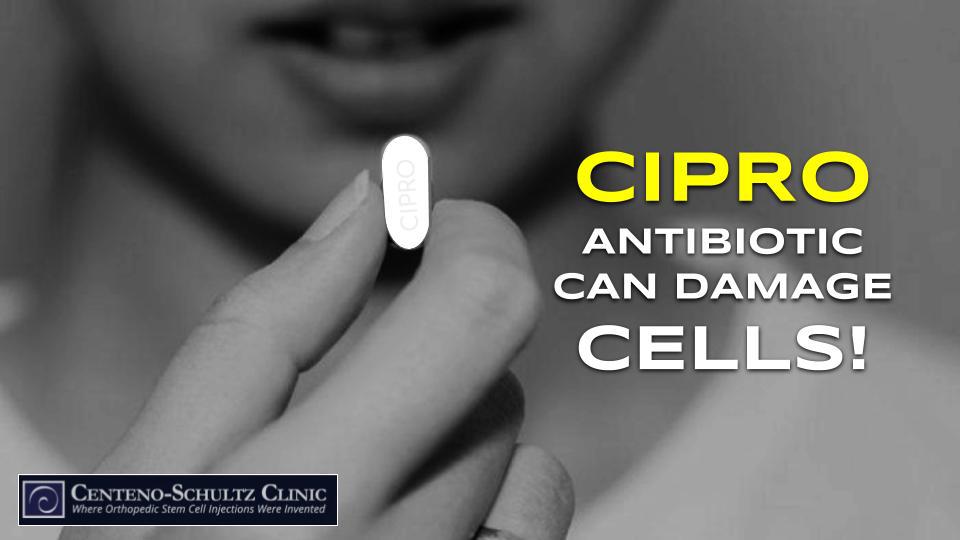We sometimes see new patients in our clinic who have had devastational results after taking quinolone antibiotics in the past, such as Cipro (ciprofloxacin). Usually, these are severe and chronic problems in their tendons, a common issue associated with these antibiotics. A recent study suggests, however, that tendon issues aren’t the only problems we should be concerned about in patients who’ve taken these drugs; it seems in an effort to destroy bacteria, Cipro is also inhibiting an enzyme that the mitochondria in cells (the cellular batteries) need to properly function. In other words, Cipro antibiotics must damage the cells to destroy the bacteria. Before we explain, let’s define quinolone antibiotics.
What Are Quinolones (e.g. Cipro Antibiotics)?
Perhaps the most common quinolone antibiotic is ciprofloxacin (brand names include Cipro, Cetraxal, etc.). The quinolone family, however is quite large and includes many, many more antibiotics. The full name of the quinolone family is fluoroquinolone, and it also includes, ofloxacin (Floxin), levofloxacin (Levaquin), norfloxacin (Noroxin), and so on. If the generic name of the drug contains “-floxacin,” this is a good sign you’re dealing with an antibiotic in the quinolone family.
Quinolones are strong prescription antibiotics (meaning, their purpose is to destroy bacteria that are causing an infection) that treat anything from UTIs (infections of the urinary tract) to dental infections to bone and joint infections, and much, much more. While some people can tolerate quinolones, unfortunately, many people cannot, and by the time you find out you’re in the latter group, much of the damage may already be done. In certain people, this damage can be devastational. For example, watch the video below of one such case where the patient experienced severe antibiotic tendonitis from quinolone antibiotics that set off a domino effect of severe problems and extreme procedures:
Mitochondria Are the Batteries of the Cells
Our mitochondria live in the cytoplasm of our cells and are the energy sources for all of our cellular functions. In essence, they are the batteries that power our cells. The energy resource is the food we consume. To power our cells, the mitochondria convert the nutrients into a chemical energy source. If that mitochondrial power is disrupted, the cell becomes weak. If the power is shut off altogether, the cell dies. This is one key to keeping cells healthy is to keep the mitochondria healthy.
Mitochondria can become damaged by many different things…even the natural process of aging, so we want to minimize those external sources that can add to this as much as possible. One of those external sources we need to be aware of when considering the health of our mitochondria and, therefore, our cells, is the antibiotic Cipro, according to one study. Let’s take a look.
Cipro’s Effect on the Mitochondria
A recent study investigated the effect of ciprofloxacin on the mitochondria. Proper mitochondrial function is dependent on the enzyme topoisomerase. This same enzyme is targeted by ciprofloxacin in bacteria that invade our body. So while Cipro antibiotics inhibit this enzyme in bacteria, killing the invader, it also inhibits it in our healthy cells that require the enzyme to function. In addition to its effect on the mitochondria, ciprofloxacin also stopped the growth and differentiation of cells.
Cells make up our tissues, so as the mitochondria are damaged by the ciprofloxacin and the cells weaken or die, this effect may be passed through the tissues as well. For example, weak and dying cells in the tendons are likely to result in damaged and ruptured tendons, and as mentioned before, tendon issues are a known side effect of quinolone antibiotics.
Quinolone Antibiotics and Tendon Problems
Achilles tendon ruptures have been a well-known side effect of quinolone antibiotics for at least a decade. This damage to the tendons has been linked to the toxic effect of the antibiotics on our body’s natural repairmen, our stem cells. Our tendons, like most of our body structures, have local healing stem cells. If these local stem cells become damaged, they can’t properly repair the tendon, and further injury is likely.
Cipro antibiotics, like many other quinolone antibiotics, is a powerhouse drug for destroying bacteria; unfortunately, in some, it may also be a powerhouse drug for damaging and destroying cells. If, like the patient in the video above, you’ve already had tendon damage due to Cipro or other quinolones, we’ve seen good results with high-dose platelet-rich plasma (PRP) injections to treat the tendon.
